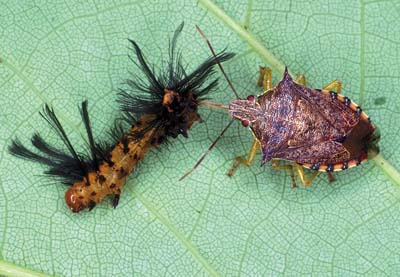
Adult Alcaeorrhynchus grandis, a predatory stink bug,
feeding on a caterpillar.
(Photographer: James Castner, University of Florida)
Stink bugs vary in length depending on the species. Males and females of the same species may differ in size. Adults vary in their appearance, body shape and color. Some are solid iridescent blue, green or purple and some are patterned with an orange, red or cream color. Adults have enlarged long and broadly oval dorsal shields. Some species are brown in color with dark bands on their legs and abdomens. The eggs are barrel-shape, vary in color and are approximately 0.1 cm in diameter. The nymphs range from 0.15 cm to 1.4 cm in length, depending on the instar, and are blackish-blue in color (some have a brownish or reddish abdomen). The later instars are blue-black in color with red markings on the thorax, and possess wing pads.
The life cycle of predatory stink bugs from egg to adult ranges from 25 to 60 days. Mating occurs during the spring and summer (depending on the species). Eggs are usually laid in rows within clusters and can range from a few in number to 200. Once hatched, the first instars will cluster together with the empty shells until they molt into the second instar. The second instars then spread out and search for food. Predatory stink bugs go through five instars before becoming adults.
Predatory stink bugs are found on peanuts, alfalfa, corn and soybeans in agricultural areas throughout the United States.
Predatory stink bugs feed on beetles, caterpillars and other soft-bodied insects or slow moving arthropods.
Images
To save the Web-optimized images shown below to your hard drive:
|
Click to access Display and Print quality images. |
|
Click to access Display and Print quality images. |
|
Click to access Display and Print quality images. |
|
Click to access Display and Print quality images. |
|
Click to access Display and Print quality images. |
|
Click to access Display and Print quality images. |
|
Click to access Display and Print quality images. |